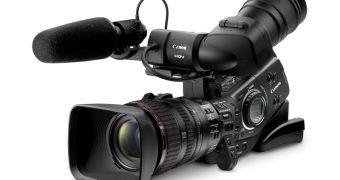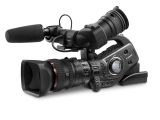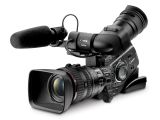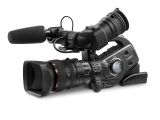Just four days before the 2008 NAB Show, Canon decided to release full details about their new XL H1S and XL H1A camcorders. Taking their top prosumer model and fiddling with it based on the desires and recommendations of their customers, Canon's new models inherit the XL H1's shoulder-mounted size and professional looks, while adding a lot of functionality to the base lens, clearing up the blunders that marred the audio features of their predecessor, and getting the software details right in all the right places. With a smart price reduction to boot!
The H1S has an MSRP of $8999, and the H1A comes in at a cheaper $5999, losing only the 'Professional Jack Pack' in the process. Those who do not need to shoot with several XL H1S's in tandem - having no use for the HD-SDI output with embedded audio and time code, and Genlock output which acts as a live switcher control for multi-camera shoots - but at the same time want the interchangeable lenses and shoulder-mounted form-factor of the XL-H1S, will appreciate the cheaper H1A which was built for their needs.
Canon tells us as much: "Many users expressed a desire for a lower cost version of the XL H1, one that did not have HD-SDI, SMPTE Time Code, and Genlock because they weren?t doing multi-camera." What some of these users might miss though, is the uncompressed 1.485 Gbps signal of the HD-SDI output, which spells both amazing image quality and incredible hassles during capture (think mobile HDD array and/or mobile compression unit).
[admark=1]But a 1/3 inch sensor? The more professional and flexible Canon's HD line gets, the harder it is for users to swallow the many caveats of a small sensor. Sony has already given us a half inch sensor with beautiful dynamic range and shallow depth of field for a similar MSRP of 8000$. And RED's announcement of the Scarlet, a camera which should fall in this price range and have a larger sensor will happen in a few days at NAB, and is expected to be ground-breaking. The H1S and H1A have a look, capabilities and a price that only attract professionals, and this is the market that Canon targets. Their clients are videographers, filmmakers, small television networks and documentary producers. Knowledgeable people who appreciate the sharpness of the Canon image and the in-camera flexibility of its color, but who are also feeling more and more entitled to the no-longer-elusive larger sensors.
The most visible change between the H1 and the H1S is the 20x zoom lens. While the zoom factor has remained the same and the quality of the lens itself is just as outstanding for this price point, an iris ring (1/16 stop increments) has been added to the already available zoom, focus and ND rings. The iris, focus and zoom rings can now be operated simultaneously. The focus ring can be customized with three sensitivity settings and zoom movements now start and stop smoothly (a software function). The fastest zoom speed is down to 1.5 seconds from 3.5, while slow zooms can be an agonizing but impressive 5 minutes (up from 1 minute).
The design has changed too, with the rings set further apart and differentiated by texture. Their degree of responsiveness can be customized. Canon advises its customers that the XL lens mount can fit all manners of Canon lenses, like the 6x wide angle lens and EF photographic lenses.
In-camera image controls have changed as well. White balance has gained range, going from 2000K to 15000 K (previously 2800K ? 12000K). The 23 color parameter options have changed their settings scale from +/- 9 to a more adjustable +/-50. It is not clear whether any change in the adjustment range itself has been introduced, but customs image pre-set files can be saved to SD/SDHC memory cards (this is especially useful for sharing between cameras in multi-camera shoots).
The limit of electronic gain that can be added to an image is now +36dB, and I am curious to see how much noise the new models will exhibit at this level of gain. For chroma-key work and special lighting situations (low background light or simply overpowering color tints in the light), a selective noise-reduction function handles noise in targeted color zones.
Finally, the display can be customized to a level approaching gadget perfection ? 22 items and 40 sub-items compose the array of status information that can be shown on the LCD or viewfinder. The viewfinder can double as an external monitor-out port, with the use of a Canon cable.
Some big changes, and not all positive, have taken place in the audio section of the XL models. On the negative side, Canon claims that their users were not interested in the 4-channel recording, so only two are available in the new camcorders. Simultaneous recording of the camera's included microphone and an external mic is now possible. The two XLR inputs have separate sensitivity settings, level switching between line and mic, and a manual audio limiter. And finally, the headphone jack has been changed from plastic to metal, for the special times when you forget to take the headphones off when walking away from your camcorder.

 14 DAY TRIAL //
14 DAY TRIAL // 


